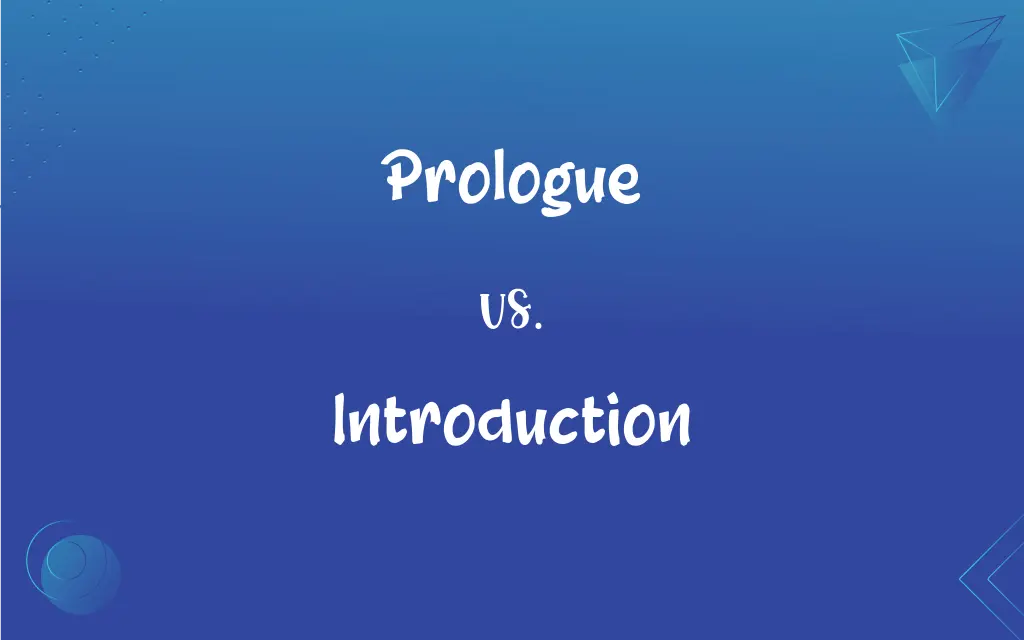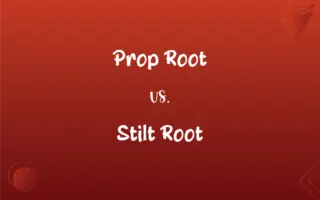Prologue vs. Introduction: What's the Difference?
Edited by Aimie Carlson || By Janet White || Published on December 5, 2023
A prologue sets the stage for a story, often with background details or events, while an introduction presents the purpose, scope, and content of a non-fiction work.

Key Differences
The prologue, typically found in fictional works, offers a narrative introduction or background to the story. It often includes events that precede the main plot, establishing context or thematic elements. In contrast, an introduction, usually in non-fiction, outlines the book's aim, scope, and structure, offering readers a guide to the content and its organization.
Prologues can be narrated by a character, an omniscient narrator, or even the author, adding layers to the story's beginning. They might contain crucial information or foreshadow events. An introduction, however, directly addresses the reader to clarify the author's intentions, provide background information on the subject, or explain the methodology used.
In terms of function, a prologue immerses the reader in the story's world, setting, or mood. It can provide historical context, introduce key themes, or offer a glimpse of events outside the main narrative's timeline. An introduction, conversely, is more straightforward, aiming to prepare the reader for the ensuing discussion, argument, or analysis.
A prologue's content is often creative and integral to understanding the story's overall arc. It may not be immediately clear how the prologue connects to the main story until later. On the other hand, an introduction is expository, explicitly stating what the reader can expect and often outlining the book's structure.
The narrative style of a prologue can vary greatly, depending on the author's intent and the story's tone. It might contain narrative elements like dialogue, descriptions, or action. An introduction is generally more uniform in style, focusing on clarity, succinctness, and providing a roadmap for the reader.
ADVERTISEMENT
Comparison Chart
Purpose
Sets the stage for a story, provides background or context.
Presents the purpose, scope, and content of a non-fiction work.
Placement
Precedes the main story, often separate from the narrative's chronological flow.
Typically at the beginning, directly leading into the main content.
Narrative Style
Can be narrative, with elements like dialogue or action.
Expository, aiming for clarity and directness.
Content
Often contains story elements, may foreshadow events.
Provides an overview of the subject, methodology, and structure of the work.
Use in Genres
Common in fiction, especially novels.
Found in non-fiction, such as academic texts, essays, or instructional books.
ADVERTISEMENT
Prologue and Introduction Definitions
Prologue
An introductory part of a play or literary work.
The prologue gave the audience a glimpse into the hero's past.
Introduction
An opening section that explains the background or context of a work.
The introduction provided a historical overview of the topic.
Prologue
A preliminary section of a book setting the stage for the story.
The prologue of the novel described a mysterious event that foreshadowed the main plot.
Introduction
A preliminary section in a book that introduces the reader to the subject.
The introduction of the textbook outlined the chapters and key concepts.
Prologue
A separate introductory section of a literary or musical work.
The prologue in the play was a monologue that introduced the central conflict.
Introduction
The initial part of a document or speech that sets the stage for what follows.
Her introduction in the report clearly stated the research question.
Prologue
An introductory speech, often in verse, calling attention to the theme of a play.
The actor delivered the prologue, setting the tone for the drama.
Introduction
The part of a piece of writing that presents the main argument or thesis.
The essay's introduction presented a compelling argument on environmental policy.
Prologue
An event or act that leads to another event or situation.
The battle in the prologue was the catalyst for the entire story.
Introduction
A section that gives a brief overview of the content and purpose of the work.
The book's introduction explained the author's motivation for writing it.
Prologue
An introduction or preface, especially a poem recited to introduce a play.
Introduction
The act or process of introducing or the state of being introduced.
Prologue
An introduction or introductory chapter, as to a novel.
Introduction
A means, such as a personal letter, of presenting one person to another.
FAQs
What is an introduction?
An initial section of a non-fiction book that outlines its purpose, scope, and content.
Do all books need an introduction?
Not necessarily, it depends on the author's intent and the book's structure.
Can a book have both a prologue and an introduction?
Yes, particularly if it's a fictional story with a non-fiction component or background information.
Is a prologue part of the main narrative?
It's often separate but related to the main story, providing context or background.
What is a prologue?
A section at the beginning of a book, especially in fiction, that sets up the story or provides background.
Can a prologue be omitted without losing the story’s essence?
It varies; in some stories, the prologue is crucial, in others, it's more supplementary.
Does a prologue always precede Chapter One?
Typically, yes, it's placed before the first chapter.
Is the style of a prologue different from the main story?
It can be, depending on the author's choice and the story's needs.
Can a prologue contain a different timeline than the main story?
Yes, prologues often depict events that occur before the main story.
Should an introduction be concise or detailed?
It should be concise but comprehensive enough to guide the reader.
Is it common for academic books to have introductions?
Yes, to outline the scope and methodology of the research.
Is a prologue essential for understanding the plot?
In some stories, it's crucial; in others, it's more of an enhancement.
How long should an introduction be?
Long enough to cover key points but concise enough to maintain reader interest.
Can a prologue be in a different point of view from the main story?
Yes, this can provide a unique perspective or additional context.
Is an introduction always at the beginning of the book?
Typically, yes, to set the stage for what follows.
Can a prologue be a flashback?
Yes, many prologues use flashbacks to provide historical or background information.
Can an introduction include personal anecdotes?
Yes, especially if it helps clarify the author's perspective or the book's relevance.
Should a prologue be written in the same voice as the main narrative?
Not necessarily; it can vary to suit the story's tone and context.
Do introductions contain citations or references?
They can, especially if they discuss existing literature or theories.
Do all introductions explain the author's intention?
Mostly, they clarify the purpose, scope, and direction of the work.
About Author
Written by
Janet WhiteJanet White has been an esteemed writer and blogger for Difference Wiki. Holding a Master's degree in Science and Medical Journalism from the prestigious Boston University, she has consistently demonstrated her expertise and passion for her field. When she's not immersed in her work, Janet relishes her time exercising, delving into a good book, and cherishing moments with friends and family.
Edited by
Aimie CarlsonAimie Carlson, holding a master's degree in English literature, is a fervent English language enthusiast. She lends her writing talents to Difference Wiki, a prominent website that specializes in comparisons, offering readers insightful analyses that both captivate and inform.







































































